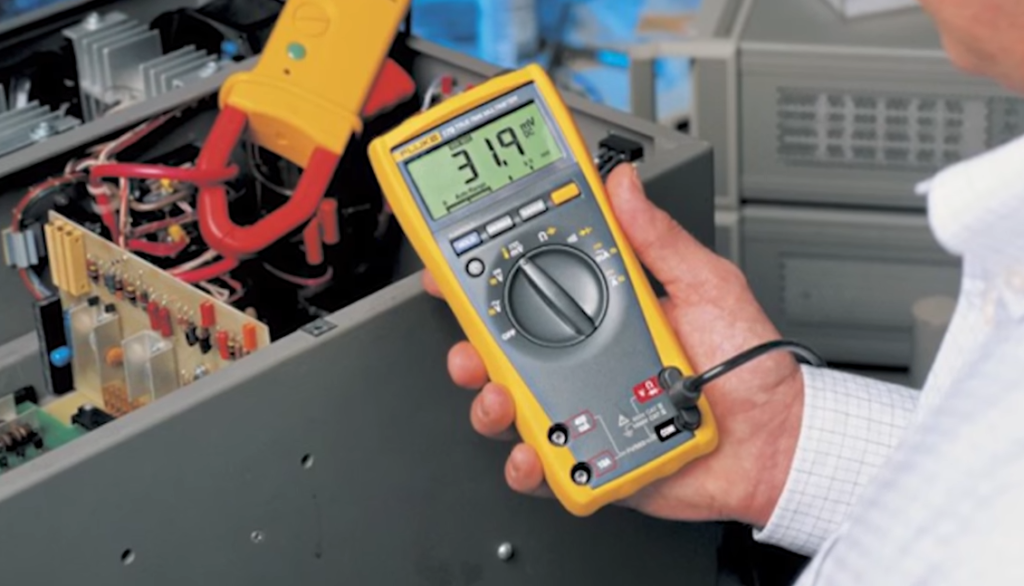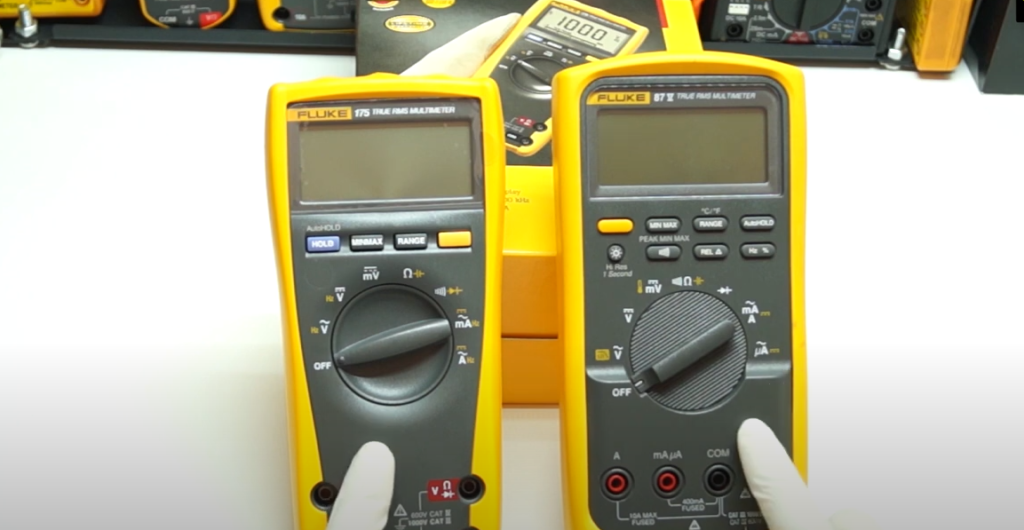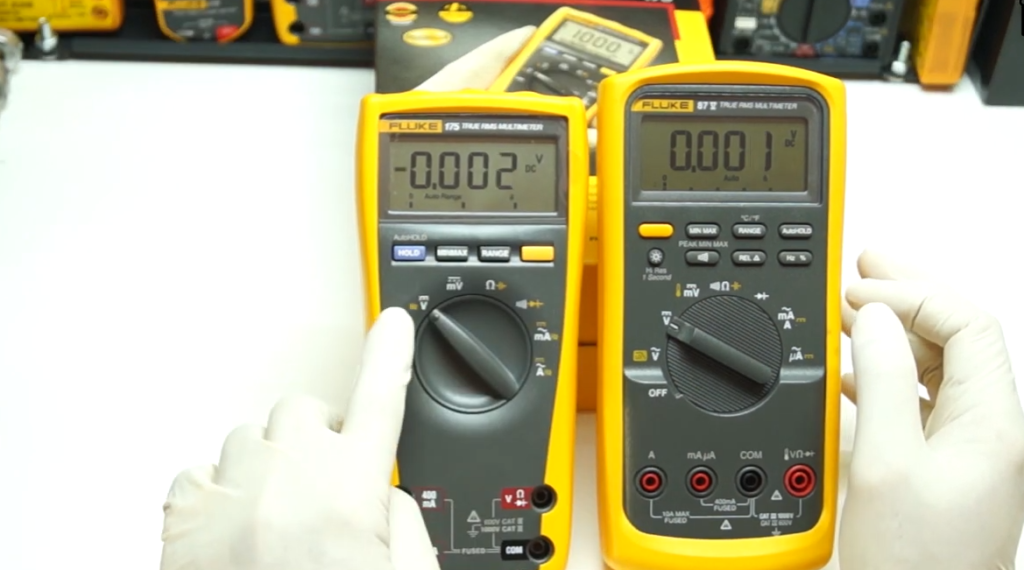When you’re looking for a quality multimeter, the options can be overwhelming. Do you want a Fluke 179 or a Fluke 87V? Both are good choices, but which one is the best for you? In this article, we’ll compare and contrast the two models so that you can make an informed decision. We’ll discuss features, pricing, and what each meter is best suited for. By the end of this article, you’ll know exactly which multimeter is right for your needs. So without further ado, let’s dive in!
Fluke Multimeters in General
Multimeters are essential tools for anyone working in electronics. They allow you to measure voltage, current, and resistance, which are the three most important parameters when working with electrical circuits. Multimeters come in a variety of shapes and sizes, but they all have the same basic function: to help you understand what’s going on inside an electrical circuit.
Digital multimeters also have a few other features that analog ones don’t, like the ability to store readings and take measurements over time. This can be very useful if you’re trying to troubleshoot a circuit or find out how it behaves under different conditions.
Fluke is a well-known and respected name in the world of multimeters. They offer several models that are popular among professionals and hobbyists alike. Two of their most popular models are the Fluke 179 and the Fluke 87V. Both of these models are feature-rich and designed for durability, making them ideal for use in a variety of settings. But which one is the best choice for you?

In the next section, we’ll take a closer look at the features of each multimeter and see how they compare. We’ll also provide some tips to help you make your decision. [1]
Comparison of Fluke 179 and 87V Multimeters
Now that we’ve taken a look at multimeters in general, let’s compare the two most popular models from Fluke. We will discuss the features of each and how they stack up against each other.
Design
Users need to be able to trust their multimeter. They need to know that it will give them accurate readings, time after time. That’s why design is so important in a quality multimeter.
Both the Fluke 179 and 87V are designed for durability. They both have a rugged casing that can withstand drops and bumps. The 179 has a slightly larger case, which makes it more resistant to damage, but it also makes it less portable. The 87V is smaller and lighter, making it more convenient to carry around.
Display
Both the 179 and 87V have large displays that are easy to read. Their displays are also backlit, so you can see them in dimly lit areas. However, the 87V display is slightly larger, at 4.5 digits, compared to the 179’s display, which is only 3.75 digits. This means that the 87V can show you more digits, making it more precise.

Accessories
Everyone likes some extras, and that’s especially true when it comes to tools. That’s why accessories are an important consideration when choosing a multimeter. Both the 179 and 87V come with a variety of accessories.
The 179 has everything you need to get started using your multimeter right away. For one, it comes with test leads, so you can start taking measurements as soon as you open the box. You can also power your multimeter right away, as it will already have a 9V battery installed.
One interesting addition to the 179 box is a temperature probe. A temperature probe is a type of sensor that is used to measure the temperature of an object. Multimeters often come with a temperature probe that can be used to measure the temperature of objects, such as electrical components. So, if you need to take temperature readings, the 179 has you covered.
The manual for this multimeter is also available as both PDF on the Fluke website and as a paper manual that comes in the box. This is great because you can always reference it if you forget how to use a specific function on your multimeter.
You will also get a holster with the 179. This is a plastic holster that you can attach to your belt. It’s great for keeping your multimeter close by and protected while you’re working.
As we mentioned already, the star item in the 179 set is the ergonomic carrying case. This is a great case because it has a lot of compartments for holding all of your multimeter’s accessories. Plus, the hard shell protects your multimeter from drops and bumps.
Now that’s a lot of extra goodies! How does the 87V compare?
The 87V comes with a few extras as well, but not as many as the 179. For one, it doesn’t come with a carrying case. This means that you’ll have to be extra careful with your multimeter, as it will be more susceptible to damage. However, it does come with a holster, so you can still keep it close by while you’re working.
Still, the 87V has some similar accessories to the 179. For example, it also comes with test leads and a pre-installed battery.
One thing it has that 179 doesn’t, is a set of alligator clips. Alligator clips are used to connect your multimeter probes to objects without having to remove any wires. This is especially useful when taking measurements in hard-to-reach places.
A 80BK Temperature Probe is also included. The 80BK is a type-k thermocouple temperature probe that can be used to measure the temperature of objects.
And don’t worry, you will have something to attach your meter to your belt. The 87V comes with a strong, black holster.
So, which set of accessories is better? Well, it depends on what you need. If you need a temperature probe or alligator clips, then the 87V is the better choice. However, if you need a carrying case or extra protection for your multimeter, then the 179 is the way to go. [2], [3]
Features
Design and accessories are only the tip of the iceberg. When it comes to choosing a multimeter, the real meat and potatoes are the features. So, let’s take a look at what each of these multimeters has to offer in terms of features.

Basic accuracy
One of the most important specs for any multimeter is accuracy. After all, what’s the point of having a multimeter if it can’t give you accurate readings? The accuracy of a multimeter is typically expressed as a percentage of full-scale reading (FSR).
The Fluke 179 has an accuracy of 0.09% + two digits, while the Fluke 87V has an accuracy of 0.05% + two digits. As you can see, the Fluke 87V is more accurate than the Fluke 179.
The difference in accuracy may not seem like much, but it can make a big difference when you’re working with sensitive equipment. If you need the most accurate readings possible, then the Fluke 87V is the better choice.
However, if you don’t need such high accuracy or you don’t mind sacrificing a little bit of accuracy for other features, then the Fluke 179 might be the better choice for you.
Both devices also are True-RMS multimeters. This means that they can give you accurate readings even when measuring AC signals that are not sinusoidal.
Low pass filter and duty cycle
The feature that the Fluke 87V has that the Fluke 179 doesn’t is a low pass filter. If you work in electronics, you’ve probably heard of low pass filters. But what are they exactly? And more importantly, why would you need one?
It’s basically a frequency selective circuit – it lets some frequencies through and not others.
There are a few reasons why you might need a low pass filter. One common reason is to reduce noise in a signal. Noise can come from all sorts of sources, like power lines, computers, or even other pieces of electronic equipment. By using a low pass filter, you can remove this noise and get a cleaner signal.
Another reason to use a low pass filter is to protect sensitive electronic components from high-frequency signals. These signals can come from the same sources as noise, but they can also come from things like radio transmitters or electromagnetic interference. By using a low pass filter, you can keep these high-frequency signals from damaging your electronic components.
The Fluke 87V also has a duty cycle function. Duty cycle is the percentage of time, in a given period, that a signal or device is turned on. For example, if a motor is on for half of the time and off for half of the time, its duty cycle would be 50%. This can be useful when testing things like solenoids or other devices that turn on and off rapidly. It’s a nice feature to have, but it’s not something that everyone needs.
In terms of features, the Fluke 87V has a few things that the Fluke 179 doesn’t. But does that make it a better multimeter? Let’s take a look at some other factors to find out.
Max operating temperature
One of the first things you’ll want to consider when choosing a multimeter is what temperature extremes it can withstand. After all, you never know when you might need to take measurements in a hot or cold environment.
The max operating temperature is one of the critical specifications to consider when choosing a multimeter. It is a measure of how hot the device can get before it starts to malfunction.
For example, the Fluke 87V has a max operating temperature of 1090°C (1994F ), while the Fluke 179 has a max operating temperature of 400°C (752F). As you can see, the Fluke 87V can withstand much higher temperatures than the Fluke 179.
Micro amp measurement
Another feature that sets the Fluke 87V apart from the 179 is micro amp measurement. Not all multimeters can measure current in the micro amp range, but the Fluke 87V can. This is a handy feature to have if you work with low-power electronics.
They are often used in low-power applications such as sensors, where a very small amount of current is required to operate the device. Microamps usually are used to measure very small electrical signals.
You might need to measure microamps if you’re working with sensitive electronic components, like those used in medical devices or communications equipment. Measuring microamps can be a tricky business, so it’s nice to have a multimeter that can do it for you.

Battery life
When working with a multimeter, one of the last things you want to worry about is whether or not the batteries are going to die on you.
The lead is pretty obvious with this one, the Fluke 87V has much longer battery life. With typical usage, you can get up to hundreds of hours on a set of batteries with the 87V. It also uses AA batteries, which are much more common, so you can find them almost anywhere.
Motor Drive Measurement
This information is important for troubleshooting and optimizing the performance of electric motors.
Among the 87V and 179, only Fluke 87V has the ability to measure motor drive current. This is a great feature if you’re working with motor drives on a regular basis. [2], [3]
Safety
Safety is always a top priority when working with electrical equipment. After all, you’re dealing with high voltages and currents that can be dangerous if you’re not careful.
Warranty coverage
Another important consideration is warranty coverage. Both the Fluke 179 and 87V come with a warranty, so you can rest assured that your investment is protected. However, there’s a difference between the two warranties. The Fluke 179 comes with a limited warranty, while the Fluke 87V comes with a full warranty.
Certifications
The Fluke 179 and 87V are both certified for use in hazardous locations. Fluke 87V has a CAT III 1000V/CAT IV 600V safety rating, meaning it can be used in environments with high voltage levels. The Fluke 179 has a CAT IV 600V and CAT III 1000V rating, making it suitable for use in environments with both high and low voltage levels.
Both multimeters also come with a certificate of calibration. This means that they’ve been tested and verified to meet the standards set by the International Electrotechnical Commission (IEC). [2], [3]
Pricing
Finally, let’s take a look at pricing. Because of the additional features, the Fluke 87V tends to be more expensive than the 179. But is it worth the extra cost? That’s something you’ll have to decide for yourself.
If you need the additional features that the Fluke 87V offers, then it is probably worth the extra cost. However, if you don’t think you’ll use those features very often, then the Fluke 179 might be a better option for you.

At the end of the day, both multimeters are great options. It really comes down to what your specific needs are and how much you’re willing to spend. Whichever one you choose, you can’t go wrong. [2], [3]
FAQ
Is the Fluke 179 a good meter?
The Fluke 179 is a great meter for general purpose use. It has a large digital display and is very easy to use. The only downside is that it has a lower temperature range than the Fluke 87V and is missing some of the more advanced features.
What is the difference between Fluke 87 and 87V?
The main difference is that the Fluke 87V has a built-in thermometer, while the Fluke 87 does not. This means that if you need to take temperature readings, you’ll need to purchase a separate thermometer.
Other than that, the two multimeters are very similar. They both can measure AC/DC voltage, AC/DC current, resistance, capacitance, frequency, and continuity. They also both have a large backlit LCD display for easy reading in low-light conditions. However 87V is obviously more advanced in that regard.
What Fluke multimeter is best for commercial use?
The Fluke 87V is the best multimeter for commercial use. It is rugged and has a large display that makes it easy to read. It has a very long battery life and is accurate. The Fluke 179 is also a good choice for commercial use, but it doesn’t offer the same range of features as the 87V.
If you’re looking for a multimeter for home use, the Fluke 179 is a good choice. It’s small and lightweight, making it easy to carry around. It has a backlit display that makes it easy to read in low light conditions. The battery life is shorter than the 87V, but it will still last long enough for most people’s needs.
Useful Video: Fluke 175 VS Fluke 87 V ( Sulit ba Ang Additional 8K Para sa 87V?)
Conclusion
That concludes our full guide on the Fluke 179 vs. 87V multimeters. We hope you found this article helpful and informative. As you can see while both multimeters are great choices, there are some key differences between the two. That’s why Fluke 87V came out on top as the best choice for most people. It’s more versatile and has more features, better temp ranges and accuracy than the 179.
But ultimately, the best multimeter for you is the one that fits your specific needs the best. So make sure to do your own research and figure out which one is right for you before making a purchase. Thanks for reading!
References
- https://web.ua.es/docivis/magnet/multimeter.html
- https://bestmultimeterreviews.org/fluke-87v-vs-179/
- https://multimetertools.com/fluke-87v-vs-179/














Leave a Reply